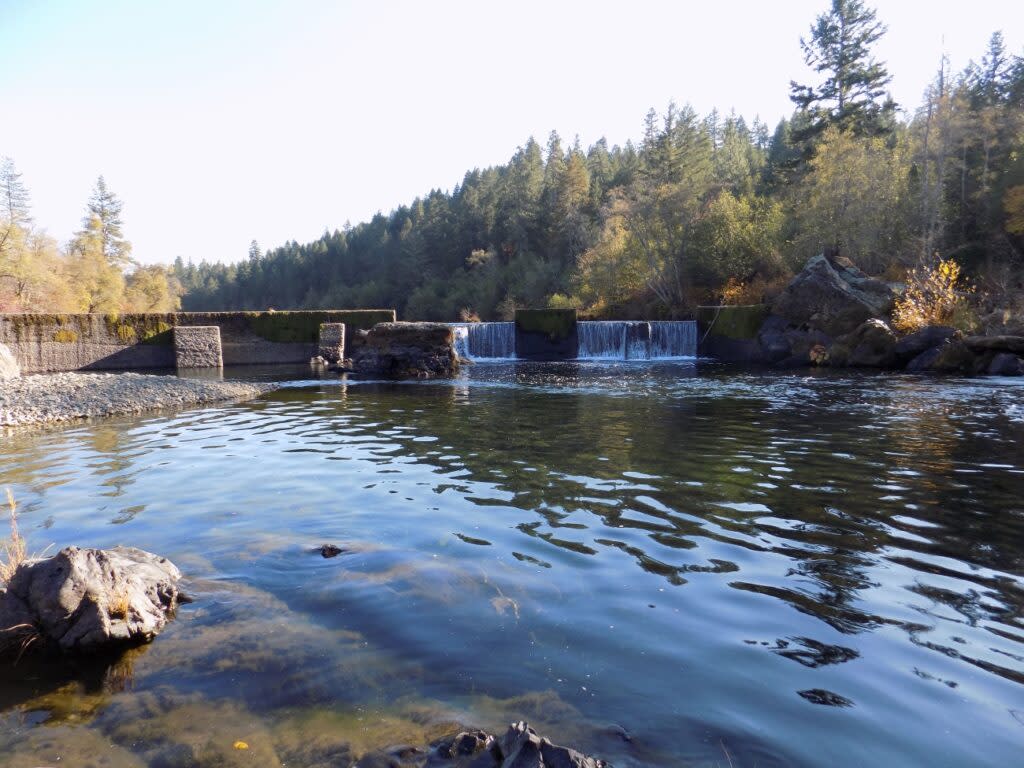Nearly $2 million in federal money headed to Oregon for dam removal, fish restoration

Build in the 1940s, the Pomeroy Dam lacks a fish ladder, making it a barrier to migrating fish. It will be removed as part of a federally funded project on the Illinois River in southern Oregon. (U.S. Fish and Wildlife Service)
The federal government has granted nearly $2 million for two projects in rural Oregon to restore habitat for endangered runs of salmon and other native fish.
The money will be used for an aging dam on the Illinois River in southern Oregon and updating infrastructure to improve fish migration on the Wallowa River in the northeast of the state.
The grants are part of $70 million in funding announced recently by the U.S. Fish and Wildlife Service for 29 projects nationwide to improve fish habitat in rivers and streams as part of its National Fish Passage Program. Since the program was founded in 1999, it has allocated about $18 million per year nationwide, but it received an extra $200 million boost from the Bipartisan Infrastructure Law for 2022 through 2026.
In Oregon, about $1.2 million of the grant will go toward the Illinois River project, and $750,000 is allocated for habitat restoration in Wallowa County. Both projects are aimed at improving fish migration in their rivers.
Illinois River project
WaterWatch of Oregon, a Portland-based environmental nonprofit with an office in Ashland, will be in charge of removing the Illinois River’s Pomeroy dam.
“This project is a high priority dam,” says Jim McCarthy, southern Oregon program director for WaterWatch Oregon. “It does not have a fish ladder, so it blocks or impedes access to 100 miles of habitat for coho, Chinook, Pacific lamprey, cutthroat trout and steelhead.”
The coho salmon that migrate up the Illinois River, a major tributary of the Rogue River, are part of a larger population that stretches down to California that are listed as threatened on the federal Endangered Species List.
In 1984, Congress added most of the river’s 56 miles to the National Wild and Scenic River System. The rare designation – less than one half of one percent of the country’s rivers are part of the system – means that no new hydroelectric dams can be constructed on them and no federal agency can fund or license a project that will affect the river’s flow. In addition to fishing, the Illinois is known as one of the most challenging whitewater rafting rivers in the Northwest.
The Pomeroy Dam, which was built in the 1940s, lacks a fish ladder, making it a barrier to migrating fish, McCarthy said. Its outdated design also adds to flooding risk when the river is high after storms.
The project is expected to be completed by the end of summer.
Wallowa County project
The Wallowa River project is led by the Nez Perce Tribe, which has long used the waterway for fishing along with other residents.
“Over the past 20 years or more, the tribe has been very active in trying to restore all native species back into the Wallowa and Lostine Rivers,” said Emmit Taylor, Jr, the tribe’s fisheries watershed director.
On the Wallowa River, the tribe will update small dams known as diversions that are designed to divert part of a river’s flow for irrigation or other use. But they can trap fish and prevent them from migrating farther upriver. The tribe wants to repair eight aging diversions in total on the Wallowa between Joseph and Enterprise, and this funding will cover the first two.
Taylor said the renovations could help steelhead, bull trout and federally threatened spring Chinook salmon migrate up the river while also benefiting residents.
“These projects are a benefit to the users of those diversions,” said Taylor, “because it updates their infrastructure so they’re much more efficient and better structures, and then just a tremendous benefit to the river itself and those fish that we’re trying to restore.”
The Nez Perce are hoping not only to restore endangered fish but also, in the long run, bring back species that have been eradicated from the area. Wallowa Lake once held tens of thousands of sockeye, but they went locally extinct in the early 20th century. The dams and overharvesting had a role in their disappearance.
“There was a very large sockeye cannery that persisted at Wallowa Lake for decades,” said Katie Frenyea, the Nez Perce Tribe’s fisheries project leader for northeast Oregon and southeast Washington.
She said the cannery and dams, not traditional tribal fishing, led to the decline.
“Along with the dam being built, those were two of the major factors that removed sockeye from the landscape.”
GET THE MORNING HEADLINES DELIVERED TO YOUR INBOX
The post Nearly $2 million in federal money headed to Oregon for dam removal, fish restoration appeared first on Oregon Capital Chronicle.

